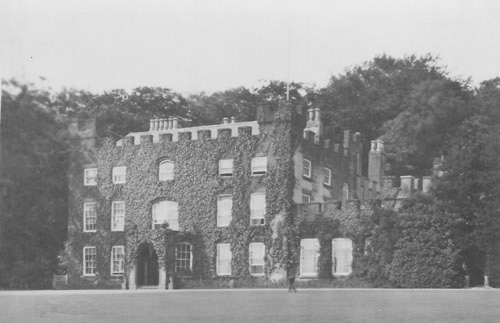Coxhoe Hall
County Durham
| Location | Coxhoe | ||
| Year demolished | 1952 | ||
| Reason | Mining subsidence and neglect | ||
| See all images: | Gallery | ||
| << Back to the main list |
Coxhoe Hall, once regarded as one of the finest houses in County Durham, is most famous for being the birthplace of the Victorian poet Elizabeth Barrett Browning.
 The first house on the site was built in the 1300s. Little is known about it apart from that is was owned by the Blakistons family and that the house was ruinous by 1418. The estate then passed to the Kennetts through the marriage of Mary Blakiston to Sir William Kennett. In 1725 it was sold to John Burdon who demolished the original Tudor house and built Coxhoe Hall.
The first house on the site was built in the 1300s. Little is known about it apart from that is was owned by the Blakistons family and that the house was ruinous by 1418. The estate then passed to the Kennetts through the marriage of Mary Blakiston to Sir William Kennett. In 1725 it was sold to John Burdon who demolished the original Tudor house and built Coxhoe Hall.
Originally the house was designed as a plain, Classical house of five bays rising to two and a half storeys with four gatehouses and set in extensive gardens and parkland and approached through a long avenue of trees. However, to keep up with changing fashions it was altered to reflect the 'Gothick' style with battlements and pointed windows. However, it was the interior for which it was renowned with fine plasterwork and fireplaces. The staircase was highly decorative featuring plaster panels, swags and cartouches, with further rococo work in the drawing room whose centrepiece was a large flamboyant chimneypiece with crossed palms and a bracket above, married to a swirling ceiling with a female figure in the centre. The plasterwork is thought to have been designed by James Paine and executed by Giuseppe Cortese (who also worked at Hardwick Hall and Elemore Hall) The style also extended to the bedrooms with coloured marble used in the settings of each fireplace. The west front of the house overlooked the tennis courts which were surrounded by beautiful flower gardens with a terrace which acted as a outdoor gallery for a collection of Roman relics.
It was into this idyllic setting which the famous poet Elizabeth Barrett Browning was born in 1806. She was not to spend long there as her family moved to a new home in Herefordshire in 1809. In the years that followed the house and surrounding countryside were increasing scarred by the industry which was to terminally blight its future. The house was sold to Anthony Wilkinson of Durham in 1817 and then to Thomas Wood, a mining engineer, in 1850 who added the single storey billard room on the right of the picture in the Gallery. The Woods lived there until 1938 when the house was sold to the East Hetton Colliery Company who proceeded to mine the estate for its coal.
Coal had been mined in the area since the 14th century but in the years of the Industrial Revolution the open countryside around Coxhoe became a damaged landscape of collieries, railways, coke ovens and quarries. As with other houses which found themselves too near industry, the house was abandoned as a home. Further neglect came with its use as barracks in 1939 before Coxhoe Hall became a prisoner-of-war camp for Germans and Italians. After the war the house became the property of the National Coal Board who condemned the house as unsafe due to subsidence. It was briefly occupied by squatters before a fire further damaged what remained.
Coxhoe Hall was finally demolished in August 1952. The ground plan and service yard of the house are still visible as are the gateposts and drive and a walled garden to the north east - though this is now overgrown. The cellars were filled in using the rubble of the house and it's said that quantities of the distinctive plasterwork can still be seen among the stones.